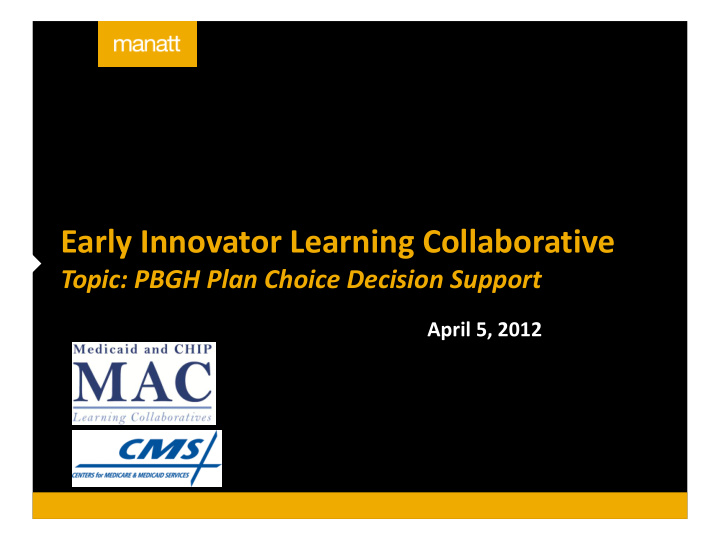



Early Innovator Learning Collaborative Topic: PBGH Plan Choice Decision Support April 5, 2012
Introduction to PBGH Project 2 Project Goal: Help Exchanges set up decision support services to assist consumers in selecting a health plan that matches their needs Key Deliverable / Timeline: Business rules to embed in consumer plan choice decision-support software. Companion health plan data element requirements to support plan choice. First installment released early March 2012. Updates planned in Q2 and Q3. This project is supported by the Robert Wood Johnson Foundation. For more information on the project contact Ted von Glahn, PBGH Senior Director at tglahn@pbgh.org.
Plan Choice Business Rules: Decision Support Rules 3 Installment 1 Topics Future Installment Topics (Delivered March 2012) (2QTR and 3QTR Deliverables) 1.Hierarchy of Plan Choice Dimensions 7. Pre-selected Defaults Influence on Plan Choice 2.Number of Plan Options to Display 8. Global Default to Simply Plan Choice 3.Plan Costs 9. Ordering Effects – Sequence of Displaying Plan Dimensions 4.Costs at Time of Care Calculator 10. Cost At Time of Care Alternative Approaches 5.Doctor Choice 11. Covered Services 6.Quality Ratings/Other Plan Performance Markers 12. Plan Features/Member Services Content 13. Exchange Decision Support Performance Management Information Are the business rules sufficiently explained – can the Exchange evaluate the rules and create technical requirements to implement desired rules? How will the Exchange use the business rules? Among Exchange staff to prepare decision support business requirements for vendor contract and/or workplan? Guide development of Exchange sponsored consumer testing? Identify resource requirements (e.g., purchase third-party data like doctor directory)? Relay to application vendor to prompt vendor proposed decision support approach? With external stakeholders (health plans, advocacy groups, providers, etc.) to provide rationale for key aspects of the consumer decision support approach? Are there plan choice decision support topics that are not addressed in the March Deliverable or in the set of topics to be addressed in 2QTR/3QTR that are a priority for the Exchanges?
Solving the Key Challenges: Consumer Plan Choice Decision Support 4 Is there work that can supplement the business rules that would be of high value to the Exchange in implementing its consumer plan choice decision support such as: Converting key business rules into syntax/data variable-specific statements to bridge the gap between a “rules description” and a “logic statement” – thus, simplify the effort for the technical folks to interpret and use the rules (see examples on slide 7)? Preparing tactical approaches to address the most challenging aspects of creating the consumer decision support experience? – structuring the information hierarchy for plan choice – integrating 3rd party data – summarizing data – roll- up selected topics to present “top - layer” information – adopting choice architecture techniques (nudges, framing, “simple path”, winnow choice set) – Commercial, Medicaid and Other LOB information integration
Converting Business Rules to Logic Statements: Examples 5 Business Rule : User preferences should elicit the importance of health plan quality ratings to the user. The user’s interest in health plan customer service can be distinguished from interest in provider network access and quality of care. As an example, the user could be queried about: Mark the box if the quality rating is important to you in comparing medical plans. I want to see how experts and plan members rate the medical plans I want to see how experts and plan members rate the doctors and hospitals in the medical plans Logic Statement : If MEDICAL PLAN RATING =1/Yes, Then retrieve plan option attribute = MEDICAL PLAN SUMMARY RATING If PROVIDER RATING =1/Yes, Then retrieve plan option attribute = PROVIDER SUMMARY RATING
Converting Business Rules to Logic Statements: Examples 6 Business Rule : Apply math logic to sum the premium and the estimated cost at time of care and display a total cost amount. Logic Statement : For each PLAN OPTION, TOTAL SUBSIDZED PREMIUM = YEARLY PREMIUM minus YEARLY TAX CREDIT plus YEARLY COST AT TIME OF SERVICE
Converting Business Rules to Logic Statements: Examples 7 Business Rule : User preferences should elicit the importance of doctor choice. The user’s interest in a particular doctor should be distinguished from the importance of having flexibility in choosing and using doctors or hospitals generally. As an example, the user could be queried about: A medical plan that includes my regular doctor is important to me A medical plan in which I can directly go to any doctor in the plan is important to me I do not want a medical plan that requires me to pick a doctor for routine care or to get an “ok” to see a specialist doctor Logic Statement: If NAMED DOCTOR = 1/Yes Then retrieve DOCTOR SEARCH function If NO PROVIDER RESTRICTION = 1/Yes Then retrieve plan options = PLAN NO PROVIDER RESTRICTION
8 APPENDIX Manatt Health Solutions January 12, 2011
9 Health Plan Choice Consumer Decision Aid Ted von Glahn Senior Director, Consumer Engagement
Plan Choice Decision Aid: Eliciting Preferences 10
Plan Choice Decision Aid: Eliciting Preferences 11
Plan Choice Decision Aid: Comparing Plans 12
Plan Choice Decision Aid: Post Plan Choice Questionnaire 13
Recommend
More recommend